The Securities and Exchange Commission (SEC) approved a new rule mandating publicly traded companies to disclose their direct greenhouse gas emissions. The proposal received backing with 3 votes to 2 at a recent SEC meeting.
The newly passed legislation titled “The Enhancement and Standardization of Climate-Related Disclosures for Investors” also requires US-based companies to disclose details on their use of carbon offsets, including the associated costs if the credits contribute to their emissions reduction targets. They also need to describe how climate change impacts their operations, financial condition, and strategies.
Moreover, companies must explain the risks and how they’re managing them, such as the impact on revenue and expenses.
What Emission Scopes Are Mandated?
The original SEC proposal initially required companies to disclose their Scope 1, 2, and 3 emissions. But Scope 3, which garnered controversy, was ultimately excluded in the final rule.
Scope 1 refers to emissions directly emitted by the company while Scope 2 covers emissions from the fuel and energy purchased by the company. Whereas Scope 3 pertains to emissions generated by customers and suppliers.
Scope 1 and 2 emissions are mandatory to report on, provided the company considers the information “material” to investors. Having this vital climate-related information will give investors insights to come up with informed decision-making.
Scope 3 emissions were the subject of significant controversy due to the challenges associated with calculating indirect emissions, which impose the highest compliance costs on companies. Big companies, particularly those in the fossil energy sector, opposed this reporting requirement.
Thus, following an extensive public comment period, which garnered 4,500 letters and 24,000 comments, the requirement to disclose Scope 3 emissions was ultimately dropped.
For the past 2 years, the SEC has been deliberating on formulating standardized requirements for corporate climate disclosure. The goal is to establish a minimum standard for transparency in boardrooms.
Now, the increased transparency required on the use of offsets would influence future purchases of carbon credits.
According to the final rule, companies will now be obligated to provide a detailed breakdown of the costs associated with carbon credits. Specifically, the approved proposal mandated that:
“The capitalized costs, expenditures expensed, and losses related to carbon offsets and renewable energy credits or certificates (RECs) if used as a material component of a registrant’s plans to achieve its disclosed climate-related targets or goals, disclosed in a note to the financial statements…”
This disclosure requirement is one of 3 main categories of information mandated in the amendments to the SEC’s final rule.
Unpacking SEC New Rule’s Key Provisions
While it’s essential for every company to thoroughly understand the SEC’s official rule, spanning almost 900 pages, 3 key provisions stand out:
- “Accelerated filers,” which are companies with publicly traded shares valued at $75 million or more, are mandated to disclose Scope 1 and 2 emissions.
- Costs stemming from severe weather events and other natural disasters must be disclosed on financial statements.
- Companies are obligated to disclose both the actual and potential material impacts of climate-related risks on their strategy, business model, and outlook.
The SEC made a significant revision to its earlier draft by removing a requirement to disclose expenditures related to “general energy transition activities” in financial statements.
Instead, the final rule focuses specifically on disclosing expenditures related to carbon offsets and RECs, as confirmed by SEC officials.
Go over to SEC’s fact sheet that summarizes the specific rules that a registrant has to disclose.
The Commission estimates that around 2,800 companies have to prepare to report on their climate-related financial risks. That’s 40% of the 7,000 US public companies registered with the SEC.
Meanwhile, about 60% of the 900 SEC-registered foreign private issuers may also be subject to the new rule.
Accelerated filers, in particular, need to start disclosing their Scope 1 and Scope 2 emissions in 2026. Below are the compliance dates companies have to keep in mind based on their filer status:

Mixed Reactions: The Impact of SEC’s Climate Disclosure Rule
The new climate disclosure rule received both praise and criticism. Former SEC commissioner Allison Herren Lee commented that:
“The new rule, unfortunately, does little to prevent companies from making vague, untested and, most significantly, unsubstantiated, statements about their carbon footprints.”
On the other hand, supporters of the new rule noted that it’s a great milestone. For Lane Jost, head of ESG advisory at Edelman Smithfield,
“There is ample room to argue the validity of this rule on all sides, but regardless, this is a historic day for enhancing common, comparable, and credible disclosure rules on climate risks for investors and issuers.”
The SEC rule marks a significant addition to the expanding global regulatory landscape for corporate climate disclosures. International companies gear up to comply with Europe’s Corporate Sustainability Reporting Directive, which mandates climate disclosures. And with California’s carbon emissions disclosure requirements introduced last year, the SEC’s rule further underscores the increasing importance of climate-related transparency in corporate reporting.
The post SEC Finalizes New Climate Disclosure Rule: Here’s What’s New appeared first on Carbon Credits.
Carbon Footprint
Bitcoin Price Hits $124,000 Record High vs Ethereum Price Near $4,800: Which Crypto Is Greener?
Bitcoin price surged past $124,000 upon writing, setting a new all-time high. Analysts credit several factors:
- strong institutional buying,
- increased inflows into Bitcoin ETFs,
- favorable regulatory changes allowing crypto assets in 401(k) retirement accounts, and
- growing market optimism over expected Federal Reserve interest rate cuts.

The rally reflects both a recovery from previous market downturns and a renewed appetite for digital assets among mainstream investors.
Ethereum, the second-largest cryptocurrency by market capitalization, is also on the rise. It is now approaching its all-time high of around $4,800, last seen in November 2021.

Investor sentiment is rising because of Ethereum’s role in decentralized finance (DeFi) and NFT marketplaces. Its better environmental profile, thanks to the switch to a proof-of-stake (PoS) model, also helps.
With both tokens in focus, let’s look at their energy use and carbon footprint. This matters for investors and policymakers who care about their climate and environmental impact.
How Bitcoin’s Proof-of-Work Consumes Energy
Bitcoin’s network runs on a process called proof-of-work (PoW). Miners around the world compete to solve complex mathematical puzzles. The first to solve it gets to add a block of transactions to the blockchain and earn newly minted Bitcoin. This process secures the network but demands enormous computing power.
That computing power uses a lot of electricity. Bitcoin’s annual energy use is estimated at about 138–178 terawatt-hours (TWh). This is similar to the electricity consumption of countries like Poland or Thailand, and even greater than Norway.
The carbon footprint is equally large, at around 40 million tonnes of CO₂ equivalent per year. To put that into perspective, that’s similar to the emissions of Greece or Switzerland.
On a per-transaction basis, a single Bitcoin payment can use as much energy as a typical U.S. household does in one to two months.
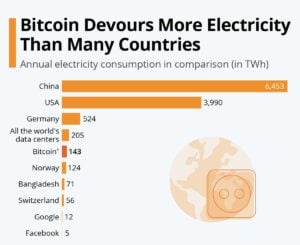
Beyond electricity, Bitcoin mining also generates significant electronic waste. Specialized mining hardware, called ASICs, becomes obsolete quickly—often within two to three years—because faster, more efficient models keep being developed. This turnover contributes thousands of tonnes of e-waste annually.
Ethereum’s Post-Merge Energy Transformation
Before 2022, Ethereum also used proof-of-work, with high energy demands. But in September 2022, the network completed the Merge, switching to proof-of-stake.
Ethereum now uses validators instead of miners. These validators “stake” their ETH tokens as collateral. This helps confirm transactions and secure the network.
This change cut Ethereum’s energy use by over 99.9%. Today, the network consumes an estimated 2,600 megawatt-hours (MWh) annually—roughly 0.0026 TWh. That’s less electricity than a small town of 2,000 homes might use in a year.
The carbon footprint is also tiny compared to Bitcoin—under 870 tonnes of CO₂ equivalent annually. That’s about the same as the yearly emissions of 100 average U.S. households. In environmental terms, Ethereum has gone from being one of the largest blockchain energy consumers to one of the most efficient.

Beyond Electricity: Hidden Environmental Costs
While electricity use is the biggest factor, it’s not the only environmental concern for both cryptocurrencies. Here are the other environmental impacts:
- Water Use:
Large-scale Bitcoin mining facilities often require substantial cooling, which can consume millions of liters of water annually. This can put pressure on local water supplies, particularly in drought-prone regions. Ethereum’s low energy profile greatly reduces such needs. - Heat Output:
Mining facilities generate significant heat. In some cases, waste heat is reused for industrial or agricultural purposes, but in most situations, it is simply released into the environment, adding to local thermal loads. - Land and Infrastructure:
Bitcoin mining operations require large warehouses and access to high-capacity electrical infrastructure. This can limit available industrial space for other uses and put stress on local grids.
By using proof-of-stake, Ethereum avoids most of these impacts. It just needs standard server equipment. This can run in data centers with other low-impact computing tasks.

How the Industry Is Addressing Bitcoin’s Footprint
The crypto industry is aware of Bitcoin’s environmental challenges and is taking steps to address them. Some of the actions taken include:
- Renewable Mining: Some mining operations use only hydro, wind, or solar energy. This is common in areas with plenty of renewable resources.
- Waste Heat Recovery: A few miners capture and reuse waste heat for agriculture (e.g., greenhouse farming) or district heating systems.
- Carbon Offsetting: Companies and mining pools are buying carbon credits to offset emissions. However, how well this works depends on the quality of those credits.
- Policy Proposals: Governments may require Bitcoin miners to share their energy sources or meet renewable energy goals.
SEE MORE: Top 5 Sustainable Bitcoin Mining Companies To Watch Out For
While these efforts are promising, the core challenge remains: proof-of-work’s high energy requirement is built into Bitcoin’s security model.
Why This Matters for ESG-Minded Investors
For investors who care about environmental, social, and governance (ESG) factors, the difference between Bitcoin and Ethereum is stark. Ethereum’s low-energy proof-of-stake model makes it easier to align with climate goals. Bitcoin’s high energy use and emissions, while partially mitigated by renewable adoption, remain a significant concern.
These factors may influence where ESG-focused funds allocate capital. Companies and institutions wanting exposure to blockchain technology without a large carbon footprint might prefer Ethereum or other PoS networks.
Bitcoin may still attract investors because of its market dominance and value as a store. However, it will likely keep facing environmental concerns.
The Road Ahead for Crypto and Climate
Bitcoin and Ethereum’s price rallies show that investor interest in crypto remains strong. As climate change and sustainability gain importance in policy and investment, environmental performance may play a larger role in the long-term value and acceptance of digital assets.
For now, Ethereum sets the standard for energy efficiency among major blockchains, while Bitcoin represents the ongoing challenge of balancing security, decentralization, and sustainability. Can Bitcoin cut its environmental impact without losing its key features? This will be an important question in the coming years.
The post Bitcoin Price Hits $124,000 Record High vs Ethereum Price Near $4,800: Which Crypto Is Greener? appeared first on Carbon Credits.
Carbon Footprint
ENGIE Lands $600M from World Bank Group and Investors to Boost Peru’s Renewable Energy
The International Finance Corporation (IFC), part of the World Bank Group, approved up to $600 million in funding to support ENGIE Energía Perú’s push into non-conventional renewable energy. Of that, $250 million is from the IFC itself, and an additional $350 million comes from other mobilized investors.
The financing structure is a Sustainability-Linked Loan (SLL), which links financial terms to performance goals. Let’s uncover where the funds will go and how this will help ENGIE’s net zero and climate goals.
Where Will the Money Go?
The goals of the fundraising are to expand renewable energy, support climate adaptation, and promote gender diversity initiatives. The first tranche of $120 million will immediately fund the acquisition and development of key renewable infrastructure.
The first installment will finance these three major projects:
- Expand the Intipampa Solar Plant: Increase capacity by 51.4 MW in Moquegua, boosting total solar output.
- Wind Farm Acquisitions: Acquire existing wind capacity of 36.8 MW at the Duna and Huambos sites.
- Battery Energy Storage System (BESS): Develop or refinance the 26.5 MW Chilca battery system—the largest in Peru—to improve grid flexibility.
These investments help ENGIE reach its goal of adding 800 MW of non-conventional renewables in five years. This will transform the country’s energy mix.
ENGIE’s Power Play in Peru’s Energy Market
ENGIE Energía Perú (EEP) is a dominant force in Peru’s energy sector. By 2024, it was the biggest electricity generator in the country. It owned about 2,694 MW from ten plants. This made up 19% of Peru’s total installed capacity and around 14% of national production.
EEP’s renewable and conventional installations include:
- Punta Lomitas Wind Farm (296 MW), the largest in Peru.
- Expanded solar capacity with Intipampa.
- Hydro and gas-fired plants such as Chilca and Ilo.
- The Chilca BESS, launched in 2023 with an investment of approximately $20 million, demonstrates its adaptability and drive for stability.
Peru’s Renewable Wave: From Hydro to Solar Growth
Peru’s electricity mix is shifting. In 2024, renewables accounted for arond 59% of electricity, with breakdowns of hydroelectricity at almost 50%, wind at around 6%, solar at almost 2%, and biomass at 0.8%.

The country boasts significant untapped renewable potential:
- Hydropower: Installed capacity stands at 5.7 GW (2020), with untapped technical potential of ~70 GW.
- Renewables Market Growth: In 2022, Peru’s renewables sector generated 34,727 GWh, valued at around $900 million, with moderate annual growth in both output and value.
Looking ahead, an IFC study predicts that by 2050, wind and solar could make up 45% of installed capacity in the country. This growth will be backed by investments in grid storage, which will help improve system resilience.
Other big investments show regional growth. For instance, Spain’s Zelestra is investing $1–1.5 billion in Peru’s renewable energy. This will support mining operations with a pipeline of 1 GW capacity.
How The Loan Could Change Peru’s Grid
The $600 million SLL from IFC is more than capital; it’s a catalyst for renewable energy growth in Peru. The key benefits include:
Increased Clean Energy: The financing helps deliver over 100 MW of additional wind and solar capacity, plus the country’s largest BESS, enhancing energy diversification.
Climate Action: IFC estimates the Intipampa expansion alone will save 61,461 tonnes of CO₂ equivalent per year by displacing fossil-based electricity.
Grid Modernization: Energy storage fosters a more flexible, renewable-friendly grid and supports off-grid electrification in rural areas.
Market Confidence: The SLL’s structure signals investor belief in Peru’s green energy potential and supports broader regional ambitions.
ENGIE’s expansion is part of a broader wave of renewable growth in Latin America. In Peru, ENGIE’s projects contribute to the broader energy transition—and set an example for public-private collaboration in sustainable infrastructure.
More notably, it forms part of the energy giant’s net zero goals.
ENGIE’s Global Renewable Energy and Net-Zero Strategy
The company’s global stance reflects increasing corporate commitment to clean energy infrastructure. The infographics below shows ENGIE’s decarbonization ambitions.
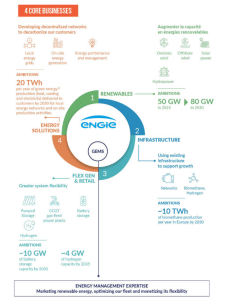
Globally, ENGIE has positioned itself as a leader in the clean energy transition. It aims to achieve net-zero greenhouse gas emissions by 2045. The company focuses on quickly increasing renewable energy capacity. It aims to phase out coal and expand energy storage solutions. This will help integrate more variable renewables.
By 2025, ENGIE targets 50 gigawatts (GW) of renewable capacity worldwide, growing to 80 GW by 2030. This expansion focuses on wind, solar, hydro, and green hydrogen projects, supported by digital tools for efficiency and performance monitoring.
ENGIE has cut its direct emissions (Scope 1) by over 40% from 2017 to 2024. This change came mainly from retiring coal assets and switching to clean energy. Below is the company’s 2024 carbon footprint.
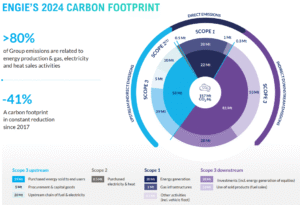
The company is investing in large energy storage, aiming for 10 GW of battery capacity by 2030. This will help keep the grid stable as more renewable energy comes online.
ENGIE’s climate roadmap includes Science Based Targets initiative (SBTi) validation, ensuring its emissions reduction pathway aligns with the Paris Agreement’s 1.5°C goal.
These global efforts reinforce ENGIE’s operations in Peru, showing how the company’s local renewable expansions contribute to a broader, coordinated push toward a carbon-neutral energy system worldwide.
Moreover, ENGIE supports strong carbon pricing policies and systems that encourage investment in low-emission technologies, energy efficiency, and reduced energy use.
As part of its path to net zero, the company plans to carry out internal carbon absorption projects and use carbon removal credits. These credits will follow the Integrity Council’s ten principles, with a focus on transparency, proving real additional impact, and ensuring that reductions last over time.
With IFC’s backing, ENGIE Energía Perú is poised to expand its renewable energy footprint significantly. The financing supports solar expansion, wind farm acquisition, and advanced energy storage. This boosts Peru’s clean energy pipeline, strengthening grid reliability, and contributing to national sustainability targets.
As Peru works toward a greener energy future, ENGIE’s investments may become a model for transformative growth across Latin America.
The post ENGIE Lands $600M from World Bank Group and Investors to Boost Peru’s Renewable Energy appeared first on Carbon Credits.
Carbon Footprint
France Eyes Bitcoin Mining Powered by Surplus Nuclear Energy
France is weighing a bold proposal to use surplus nuclear energy in Bitcoin mining, turning unused power into millions in revenue. The five-year pilot is backed by the far-right Rassemblement National (RN) party. It would use EDF (Électricité de France)’s excess electricity during low-demand hours, with heat reuse systems warming homes and greenhouses.
If approved, it could make France the first EU nation to weave crypto mining into its official energy strategy.
From Waste to Wealth: The Surplus Power Plan
France’s far-right party, RN, is backing a bold plan that could repurpose surplus nuclear electricity to power Bitcoin mining. MP Aurélien Lopez-Liguori introduced an initiative for a five-year pilot program. It aims to use excess energy from EDF-run nuclear plants for crypto mining.
The pilot allows Bitcoin mining to run only when nuclear energy is more than needed, like at night. This way, it uses power that would otherwise be wasted. Developers say one gigawatt of extra nuclear power could make $100–150 million in BTC revenue each year.
The plan also includes heat reuse systems that will capture waste heat from mining rigs. The heat can then warm homes, greenhouses, or industrial facilities. This model is already in use across Scandinavia.
Why Nuclear? France’s Energy Context
France, the EU’s top nuclear energy producer, gets over 70% of its electricity from nuclear plants. This amounts to 338,000 GWh each year. However, during low-demand periods, power supply often surpasses consumption.

France occasionally sells extra power at negative prices. Sometimes, it even pays for nearby countries to take this power, leading to losses of hundreds of millions. Bitcoin mining offers a way to monetize this surplus and ease grid stress.
Mining rigs can quickly adjust their load, providing a flexible buffer that stabilizes grid operations. This strategy supports wider energy transition goals. It helps manage inflexible nuclear output more effectively.
Political 180: From Crypto Ban to Bitcoin Boost
This move marks a dramatic shift in RN’s stance on crypto. In 2016, Marine Le Pen condemned cryptocurrencies as elitist tools and pledged to ban them. By 2022, she softened her position to support regulation. In 2025, she supports Bitcoin mining as a smart economic tool. This shows a wider trend of political practicality.
However, not all RN lawmakers agree. Jean-Philippe Tanguy, the party’s finance chief, argues that Bitcoin undermines centralized monetary control.
Meanwhile, the left and green parties oppose the plan due to its environmental impact, pointing to Bitcoin’s intensive energy use. Approval will require navigating internal party splits and environmental scrutiny.
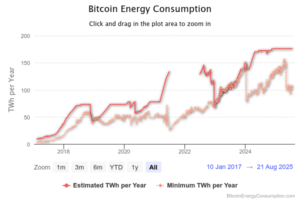
Potential Benefits and Concerns
Supporters of the proposal see several clear advantages. First, surplus nuclear power can generate revenue. Estimates show it could bring in $100–150 million each year for every 1 GW of excess output.
Second, bitcoin mining facilities can be a flexible load for the grid. They absorb extra electricity when demand is low. Then, they can power down fast when demand rises. This helps stabilize the system.
Third, the heat generated by mining rigs could be captured and reused to warm buildings or support greenhouse agriculture. This improves overall energy efficiency.
However, critics raise valid concerns:

- Environmental impact: Despite cleaner power, increased Bitcoin mining still uses heavy energy. The chart above shows that Bitcoin alone utilizes more power than most countries.
- Regulatory challenges: The proposal needs strong legal and policy backing—June’s similar amendment failed on procedural grounds.
- Public perception: Tying climate-smart infrastructure to crypto may provoke resistance.
INTERESTING READ: The Energy Debate: How Bitcoin Mining, Blockchain, and Cryptocurrency Shape Our Carbon Future
Global Trends: Nuclear Meets Bitcoin Mining
This move in France aligns with growing interest worldwide in matching crypto mining with low-carbon energy. Here are some major facts to know:
- Clean Energy Uptake: More than 52% of global Bitcoin mining now runs on sustainable energy. Of this, about 11% comes from nuclear sources.
- Fuel Mix Shifts: Coal and gas once dominated Bitcoin’s electricity supply. But the share of nuclear has roughly doubled from 4% in 2021 to over 11%.
- Energy Use Scale: Bitcoin mining is energy-intensive—estimated at 176–180 terawatt-hours (TWh) annually, on par with national consumption by countries like Poland or Egypt.
- Hashrate Surge: The Bitcoin network’s computing power, or hashrate, continues to rise. As of May 2025, it exceeded 831 exahashes per second (EH/s), a 77% jump from its 2024 low.
- Adaptation to Costs: With mining profitability squeezed, miners seek cheap, stable energy like nuclear to stay competitive.
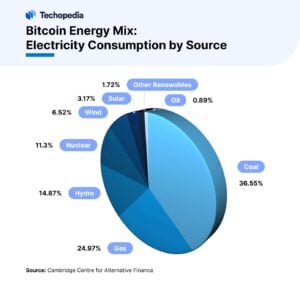
Analysts at ScottMadden argued that Bitcoin mining paired with nuclear energy offers a compelling value proposition—a clean energy use case that could diversify utility income. The business case has only grown stronger as Bitcoin prices rose from about $9,275 in 2020 to over $47,000 by 2021.
France isn’t alone in exploring this pairing. Studies suggest that Bitcoin mining might use extra power wisely. This could cut waste and help the grid stay flexible. For example, South Korean researchers found surplus electricity could be a new revenue stream for the power utility while stabilizing the grid.
Moreover, academic models propose a zero-emissions energy system. This system combines nuclear power with crypto-mining. In this setup, mining serves as a flexible load that helps balance demand. Also, many devices around the world already rely on constant nuclear power.
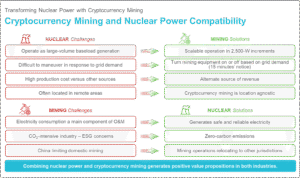
The Road Ahead: Regulation, Revenue, and Resistance
If the pilot moves forward, EDF and lawmakers would need to finalize guidelines, site mining hubs near existing infrastructure, and ensure regulatory oversight. A six-month feasibility review by the French Council of State is planned, followed by expansion if the pilot succeeds.
When that happens, France could become the first EU nation to legally integrate Bitcoin mining into its energy roadmap. It could turn an economic burden—unused power—into a revenue stream while mitigating grid stress. This would spark debate across Europe—might other nuclear-rich countries follow suit?
From a crypto standpoint, the move elevates mining from underground activity to a strategic industrial asset, redefining its role in the energy economy.
However, the plan still faces political, environmental, and technical hurdles. Yet, as the proposal gains traction, it may shape how nations view the intersection of crypto, energy policymaking, and sustainability.
The post France Eyes Bitcoin Mining Powered by Surplus Nuclear Energy appeared first on Carbon Credits.
-
Climate Change2 years ago
Spanish-language misinformation on renewable energy spreads online, report shows
-
Climate Change Videos2 years ago
The toxic gas flares fuelling Nigeria’s climate change – BBC News
-

 Greenhouse Gases1 year ago
Greenhouse Gases1 year ago嘉宾来稿:满足中国增长的用电需求 光伏加储能“比新建煤电更实惠”
-

 Climate Change1 year ago
Climate Change1 year ago嘉宾来稿:满足中国增长的用电需求 光伏加储能“比新建煤电更实惠”
-

 Carbon Footprint1 year ago
Carbon Footprint1 year agoUS SEC’s Climate Disclosure Rules Spur Renewed Interest in Carbon Credits
-
Climate Change2 years ago
Why airlines are perfect targets for anti-greenwashing legal action
-
Climate Change Videos2 years ago
The toxic gas flares fuelling Nigeria’s climate change – BBC News
-
Climate Change2 years ago
Some firms unaware of England’s new single-use plastic ban







